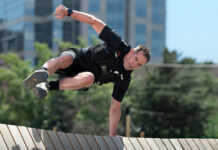
He’s plenty big. And he throws darned hard. But Mike Soroka knows that is not nearly enough.
Not when you’re aiming to become one of only 150 starting pitchers employed in Major League Baseball.
A rare Canadian drafted in the first round, No. 28 overall in 2015 by the Atlanta Braves, Soroka took home a $1.97 million signing bonus as a marker of his pro potential. He played with the Braves’ Single-A minor league team last year in Rome, Ga., then hustled home to Calgary and back into the gym.
“If I took much more time off, I’d be letting (my previous work) go to waste,” says the 19-year-old. “So I try to keep building.”
The picture of dedication, Soroka – under the watchful eye of Jeff Osadec, strength and conditioning coach for Canadian Sport Institute Calgary – trains five days a week at WinSport’s high performance centre.
No shock, the customized regimen, featuring free weights and medicine balls, is pitching-specific.
Bulking up is never the point.
There’s only so much strength you actually need to throw a baseball – it’s a five-ounce ball.
“Moving faster is a big goal,” says Soroka, six-foot-five, 229 pounds. “There’s only so much strength you actually need to throw a baseball – it’s a five-ounce ball. But you need to be able to move fast and use all that strength. It’s pointless to be a big hunk of muscle on the mound if you can’t use it.”
Soroka’s lively right arm may be his money-maker – it can, after all, produce 95 mile-per-hour fastballs – but dedicating the two-hour sessions to a single limb is foolish.
“A lot of the strength stuff we do is geared towards stability, because stability means consistency … with mechanics, endurance,” he says. “It’s about being able to repeat it over and over again (on the mound).”
Soroka has unique concerns to address, too. A growth spurt in junior high – eight inches in a single year – bolstered his fastball, but played havoc with his frame.
“Bad sciatica pain,” he says. “That’s one thing I’ve overcome a bit and continue to do so. A lot of my exercises keep my glutes firing in the proper order. That’s what the problem was – I grew so much, I wasn’t using all the muscles properly. It was putting too much stress on my back.”
Flexibility, somewhat surprisingly, is not a priority.
A certain tightness, he says, gives a pitcher’s arm that desirable snap.
“If you’re shooting an elastic you want a strong one … you don’t want some loosey, goosey thing or there’s going to be no power behind it,” says Soroka, who reports to Braves’ spring training in Orlando, Fla., in February. “You’re loading up and you’re trying to get that last piece of energy out of your body and into that ball.”
Major League Workout
Mike Soroka’s off-season work week:
Monday
- Full-body weightlifting session, plus mobility-correction exercises, core work, shoulder/scapular stability work.
Tuesday
- High-intensity cardio/strength circuit training designed to elevate the heart rate.
Wednesday
- Full-body weightlifting session, with emphasis on speed, plus core work, shoulder/scapular stability work.
Thursday
- Pure cardio, either running or stationary biking, with intervals to simulate being on the mound.
Friday
- Full-body weightlifting session, heaviest load of the week, plus core work, shoulder/scapular stability work.
Saturday/Sunday
- Off.
















